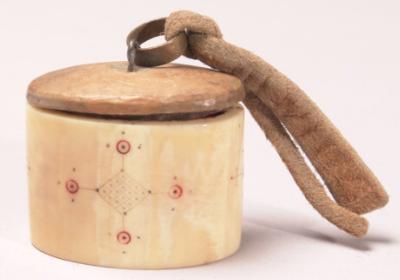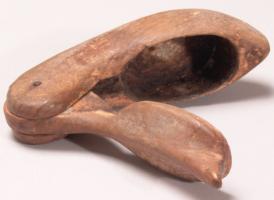Were mushrooms served at the first Thanksgiving in 1621? History has left us two eyewitness accounts of that event. Edward Winslow wrote that the mighty Indian king Massasoit and ninety of his men joined the Pilgrims at Plymouth, where they entertained one another and feasted together for three days. William Bradford described a menu of fish, waterfowl, venison, wild turkey and Indian corn. Neither man mentioned mushrooms. However, some folks might speculate that if an Indian king was present, it's a good bet tobacco played a role in the festivities. And if tobacco was present, it's arguable that a mushroom was present too. That mushroom could be a conk called Phellinus igniarius.
Phellinus igniarius is classified as a polypore, with pores on the underside that bear basidiospores. It is closely related to Phellinus tremulae, another one of the causes of heartrot in trees. Phellinus igniarius is also a member of the Hymenochaetaceae, an enormously variable family of Basidiomycota that have certain microscopic characters that hold them together. All are xanthochroic (turn black in 3% KOH) and have simple septa rather than clamps on their dark hyphae. All of them cause a white rot in wood. In addition many have dark-colored setae or setal hyphae for protection.
The species that we call Phellinus igniarius is probably a complex of species, with several "cryptic" (hidden) species. The broadly defined species is very variable, with a wide host range, growing on many kinds of hardwoods. It can be found in most boreal regions. In previous times, some researchers considered P. igniarius and P. tremulaeto be the same species. However, host distribution and microscopic characters, along with recent DNA evidence, have clearly separated the species. According to Gilbertson, R. L. and L. Ryvarden (1987. North American Polypores. 2:576. Fungiflora, Oslo) this complex also includes P. artcostaphyli (only on Arctostaphylos) and P. pomaceus (only on Prunus). Other species in addition to these four, including Phellinus laevigatus and P. nigricans, cause similar symptoms and are often grouped together by forest pathologists. You can read more about forest pathogens at www.forestpathology.org
All of these Phellinus species are perennial, producing a new pore layer every year. Some can even live 20 or more years. However, the fungus itself is not as interesting as its interactions with people.
So, what about the history of Phellinus igniarius and indigenous peoples of North America? It's actually a very interesting story.
The history of plant use for recreation, stimulation and ceremony reaches back thousands of years. Evidence exists in the form of figurines, pots, pipes and grave goods. Plants like coca, tobacco, coffee and tea have been smoked, snuffed, chewed, brewed, ingested and even rubbed on the body. These plants contain alkaloids packing powerful physiological punches. Among the alkaloids are caffeine, nicotine, morphine, codeine and cocaine, the -ines. Our early ancestors knew them well. Some plant alkaloids were useful for killing, like strychnine, curarine and coniine from the poisonous water hemlock. Others gave a person energy, fearlessness, heightened awareness or welcome relaxation.
 There is also evidence that when these plants were used, they were frequently mixed with lime or ash. You might wonder why you would want to mix a gritty, ill-flavored mess of gray paste with a leaf intended for chewing. The answer is that the alkaline enhances the buzz you get from the leaf. The chemical action of the alkaline substance on plant alkaloids helps release the alkaloids from the leaf and boosts their effect in the body. It is also likely that the presence of heavy metals plays a role in increasing the "buzz."
There is also evidence that when these plants were used, they were frequently mixed with lime or ash. You might wonder why you would want to mix a gritty, ill-flavored mess of gray paste with a leaf intended for chewing. The answer is that the alkaline enhances the buzz you get from the leaf. The chemical action of the alkaline substance on plant alkaloids helps release the alkaloids from the leaf and boosts their effect in the body. It is also likely that the presence of heavy metals plays a role in increasing the "buzz."
This potent combination of alkalines and alkaloids was discovered early in the long history of civilization. Among the Incas, for example, coca leaf was chewed to combat fatigue and mask hunger. Adding a paste of lime (pulverized rock or seashells) or wood ash gave the chew an extra kick. You could even call it Inca crack. In fact, they had discovered what we now call freebasing.
Many other early people made this discovery. In northern North America, the ash of Phellinus igniarius conks was widely used with indigenous plants before tobacco arrived. The Denaina, an Athabascan Indian people of the Alaskan interior, chewed a mixture of P. igniarius ash and balsam poplar bark in pre-contact times. Collections in Canadian and US museums show that P. igniarius was used with tobacco by the Micmac of Nova Scotia, Inuit of Labrador, Blackfoot of the North American Plains and Kwakiutl of the Pacific Northwest. This specific basidiocarp was selected and preferred above all other sources of ash. The reason for this is its high pH. But did each group rediscover this for itself? We can probably assume that both folkways and close observation of nature were at work here.
We also might dare to wonder whether fungus ash was present in tobacco at the first Thanksgiving. As tobacco trade moved north, trade in Phellinus ash could well have moved south. And a major gathering and feast would be just the occasion to bring out all the finest commodities. Following these arguments, perhaps we can establish a circumstantial case for fungus at the first Thanksgiving.
By 1621, tobacco was widely known in Europe. Columbus had brought tobacco leaves back to Spain, where they initially met with a bad reception. A conquistador named Rodrigo de Jerez lit up a cigar and was jailed for three years for it. But nothing could stop the spread of this enticing and very habit-forming leaf. The tobacco trade spread through Europe to Poland and Sweden, to Russia and along traditional Asian trade routes to Eastern Siberia. By 1750, tobacco was a valuable trade article in the New World's Pacific northwest, having returned full circle to the continent where it originated.
Once tobacco arrived in Alaska, the indigenous peoples formulated a blend of tobacco and Phellinus ash, also called punk ash. In the native language of Yupik, this mixture is called iqmik. Iqmik was (and still is) made by mixing shredded tobacco leaves and punk ash. It can also be made by rolling pieces of leaf around a portion of ash, like little doulmas. A man might give the quid to his wife to chew until the substances were mixed. Then she would return it to her husband, who held the quid in his cheek and let the juice trickle down his throat.
 Beautifully fashioned and decorated wood, bone and ivory boxes were made to hold punk ash or quids that still had life in them. The images of the quid boxes are courtesy of the Anchorage Museum of History and Art, donated to the museum by the Huffmon family, particularly Betty Huffmon of Goodnews Bay, Alaska, where most of these objects were collected. Just to orient you, Goodnews Bay is on the southwest coast of Alaska, just north of the Alaska Peninsula. According to Walter Van Horn at the Museum, Betty Huffmon, born in1920, said that "everybody had a quid box" during her childhood. To possess iqmik was to show the world that you were a successful hunter with a full storehouse. You were able to take time off from subsistence activities and you were also willing to share your iqmik with others.
Beautifully fashioned and decorated wood, bone and ivory boxes were made to hold punk ash or quids that still had life in them. The images of the quid boxes are courtesy of the Anchorage Museum of History and Art, donated to the museum by the Huffmon family, particularly Betty Huffmon of Goodnews Bay, Alaska, where most of these objects were collected. Just to orient you, Goodnews Bay is on the southwest coast of Alaska, just north of the Alaska Peninsula. According to Walter Van Horn at the Museum, Betty Huffmon, born in1920, said that "everybody had a quid box" during her childhood. To possess iqmik was to show the world that you were a successful hunter with a full storehouse. You were able to take time off from subsistence activities and you were also willing to share your iqmik with others.
Today, over 50% of Yupik Eskimo people in the Yukon-Kuskokwim Delta still use iqmik. Among pregnant women, use rises to an alarming 80%. The users reason that since the ingredients are all natural (dried tobacco leaves direct from Kentucky and punk ash from the Alaskan interior), iqmik is less harmful to a fetus than commercial tobacco products. In this they are mistaken. Iqmik serves up a powerful dose of nicotine poisoning to both mother and fetus. Health agencies are working hard to redirect this aspect of Yupik culture.
Meanwhile, an entrepreneur in the Y-K Delta can make $40 for an eight ounce jelly jar of punk ash. He will travel upriver and inland into birch forests to collect Phellinus igniarius conks. He will incinerate the conks in a coffee can placed in a fire, and sift the ash. In Bethel and other towns and villages, the ash will be sold in general stores in zip-lock bags, along with leaf tobacco, to customers who make iqmik. A rare, traditional use of a basidiocarp will continue a little while longer in a very old culture that is rapidly changing today.
 This month's co-author is Diane Pleninger, a non-professional mycologist from Anchorage, Alaska. She is an award-winning author, having won (among others) the 2003 international essay contest cosponsored by the British magazine "The Economist" and Shell Oil for her essay on the fungus Pilobolus. Diane's entry was judged the best among nearly 6,000 entries from 163 countries, according to a press release issued by organizers at the Economist and Shell. In real life she's an accountant, but she writes for her own (and others') pleasure. I'm very happy to have her as a co-author this month.
This month's co-author is Diane Pleninger, a non-professional mycologist from Anchorage, Alaska. She is an award-winning author, having won (among others) the 2003 international essay contest cosponsored by the British magazine "The Economist" and Shell Oil for her essay on the fungus Pilobolus. Diane's entry was judged the best among nearly 6,000 entries from 163 countries, according to a press release issued by organizers at the Economist and Shell. In real life she's an accountant, but she writes for her own (and others') pleasure. I'm very happy to have her as a co-author this month.
I hope you enjoyed learning about Phellinus igniarius, Iqmik. It's not a very attractive mushroom, but it has a very interesting history.
Bibliography
Iqmik:

 Tom Volk's Fungus of the Month for November 2005,
Tom Volk's Fungus of the Month for November 2005, 